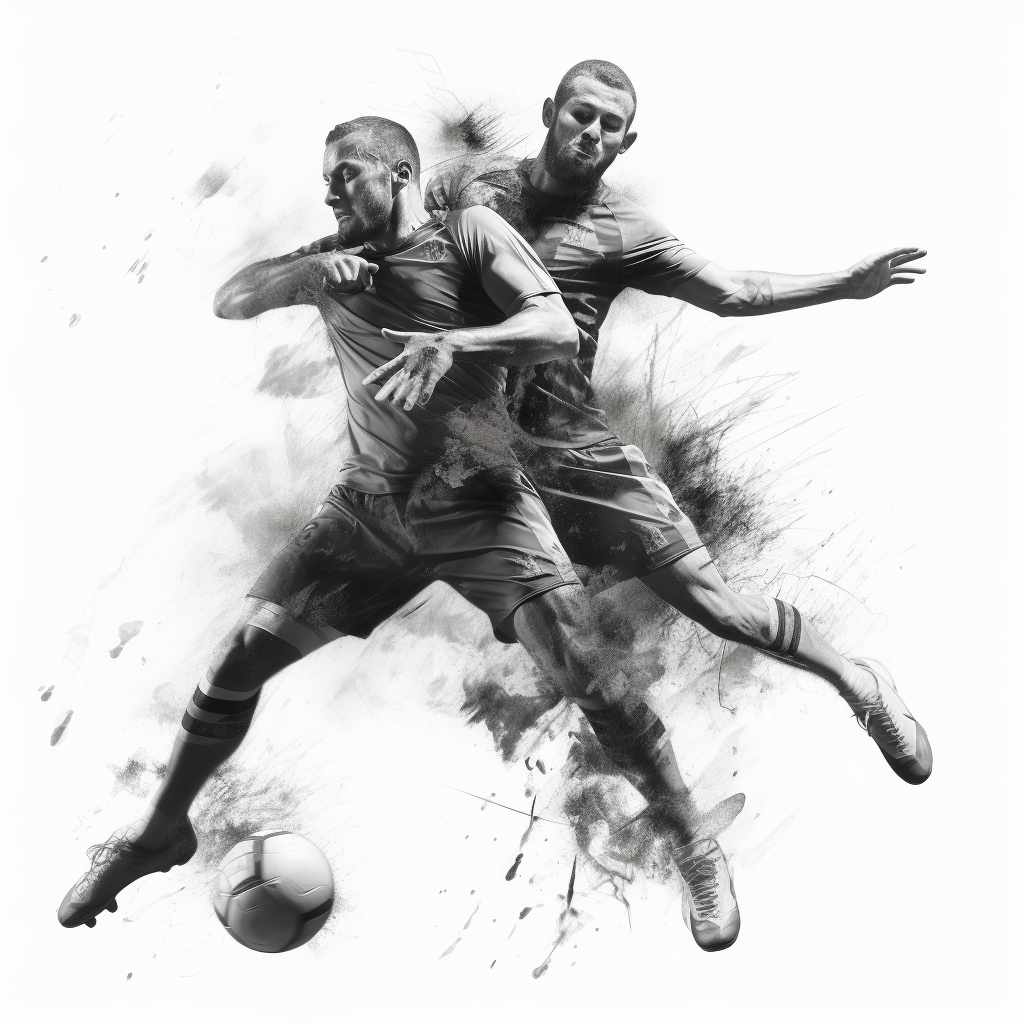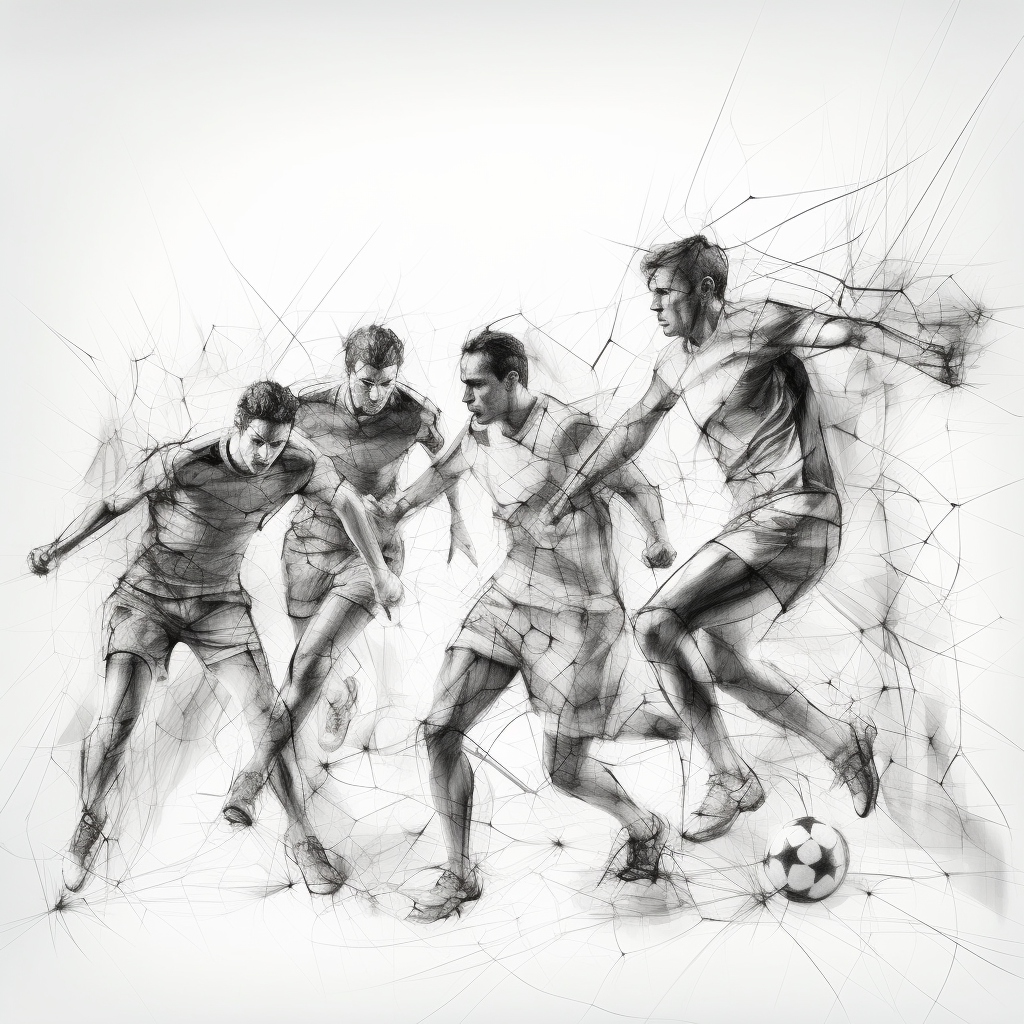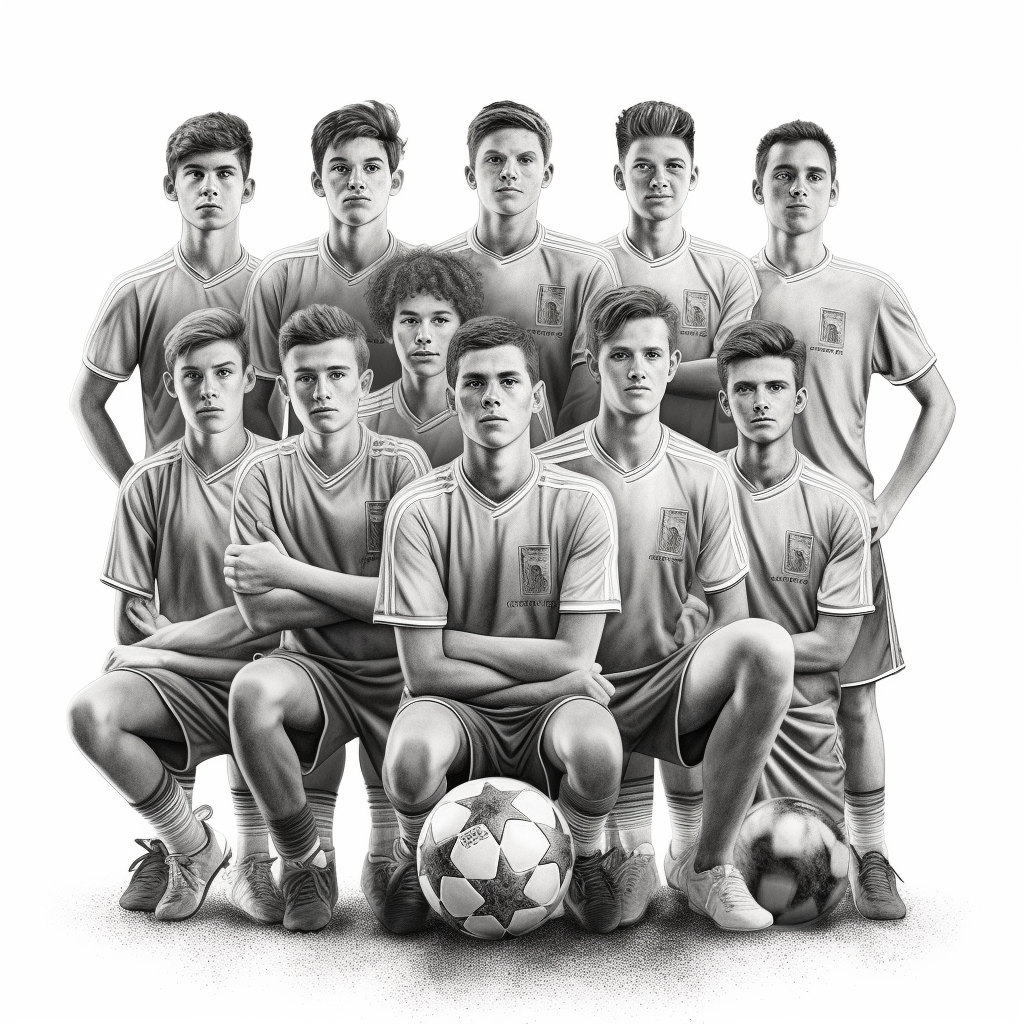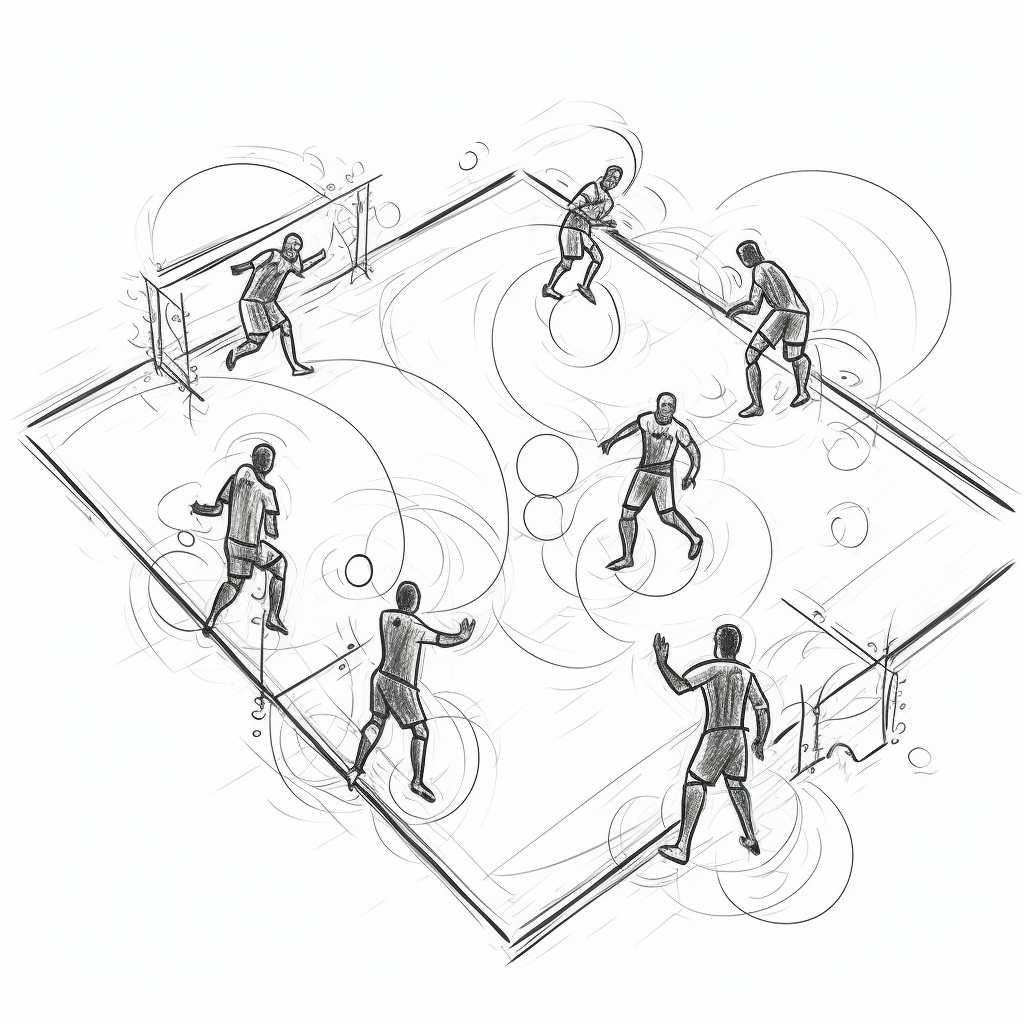
In the grand tapestry of soccer, every headline has its significance, its unique story to tell. Yet, often, it’s the flamboyance of a striker or the creativity of a midfielder that captures the public imagination.
But there lies a different kind of art, one less celebrated but equally vital — the art of soccer defending.
It’s a realm where anticipation meets resilience, where strategy intertwines with raw physicality.
It’s a chess game at full speed, a discipline that demands not just physical prowess but a deep understanding of the game’s psychology and tactics.
…and here, in these intricate battles of will and skill, games are truly won.
Understanding the Basics of Soccer Defending
Playing defense is not just a role but an art form, requiring a symphony of skills, awareness, and teamwork.
It’s about creating a fortress, not just with physical prowess, but with a deep understanding of the game’s ebb and flow. This section will unravel the core principles of effective soccer defense, setting the foundation for more advanced strategies and techniques in the event of needing to park the bus.
The Philosophy of Soccer Defending:
Proactive vs. Reactive:
Good defense is not just about reacting to the opponent’s moves; it’s about anticipating them.
It’s a mindset of staying one step ahead, predicting and nullifying threats before they fully materialize.
Balance and Flexibility:
Defense is a balance between maintaining a solid structure and being flexible enough to adapt to the dynamic nature of the game.
It’s about understanding when to hold the line and when to adapt to the unfolding scenario.
Key Defensive Skills:
Positioning:
Essential for closing down spaces and cutting off passing lanes. Proper positioning can deter attacks even before they begin.
Tackling:
A crucial skill, but one that must be executed with precision and timing to avoid fouls and maintain possession.
Intercepting:
Reading the game and intercepting passes can turn defense into attack, making it a pivotal skill in modern soccer.
Communication:
A defense that communicates effectively works as a cohesive unit, adjusting collectively to threats and opportunities.
Teamwork in Defense
Understanding Roles:
Each player in a defensive unit has a role, from center-backs who anchor the defense to full-backs who offer width and support.
Collective Movement:
A well-drilled defense moves as one, maintaining shape and compactness to reduce space for opponents.
Support and Cover:
Players must support each other, providing cover and options to diffuse pressure and regain possession.
Mental Aspects of Defense
Concentration:
Defense requires constant vigilance. A momentary lapse can lead to opportunities for the opposition.
Resilience:
Defenders must have the mental fortitude to remain focused and undeterred, even in challenging situations.
Physical Conditioning:
Stamina and Agility:
Defenders need the endurance to maintain performance throughout the match and the agility to respond to fast-changing situations.
Strength:
Physical strength helps in winning duels, shielding the ball, and effective tackling.
Understanding these basics forms the cornerstone of excellent defensive play. It’s not just about the individual brilliance of defenders but about how they synchronize their skills, awareness, and mental fortitude to form an impenetrable unit. As we delve deeper into the nuances of soccer defense, remember that these fundamentals are the bedrock upon which great defenses are built.

The Evolution of Defensive Strategies in Soccer
The landscape of European soccer is a rich playground of innovation, where defensive strategies have evolved dramatically over the years.
This evolution is not just a chronicle of changing tactics, but a reflection of the sport’s growing sophistication and the perpetual chess game between offense and defense.
Let’s trace this journey of evolution, understanding how defensive play has transformed in the European context.
1. Early Foundations and the Catenaccio:
Origins: In the early years, soccer strategies were rudimentary, often focusing more on attacking play. However, as the game developed, the need for structured defense became evident.
Catenaccio: Originating in Italy, this strategy became synonymous with a ‘lock-down’ defense. It emphasized a highly defensive approach, relying on a sweeper (‘libero’) behind the main defensive line to clean up attacks and initiate counterplays.
2. Total Football and the Shift in Defensive Thinking:
Total Football Revolution: Pioneered by Dutch teams in the 1970s, this approach changed the landscape. It introduced fluidity, where players, including defenders, were expected to contribute to all aspects of the game.
Impact on Defense: This era saw defenders taking more active roles in possession and attack, leading to a more dynamic and flexible approach to defense.
3. The Rise of Zonal Marking:
From Man-Marking to Zones: Traditional man-marking gave way to zonal marking, where defenders are responsible for areas of the pitch rather than specific opponents.
Advantages: This shift allowed for better coverage of space, reduced vulnerabilities to quick positional changes, and supported a more cohesive team structure.
4. Modern Defensive Strategies:
High Press and Aggressive Play: Contemporary strategies often involve high-press systems, where teams defend from the front, applying pressure on opponents high up the pitch.
Compactness and Transition: Modern defenses are characterized by their ability to remain compact and quickly transition between defense and attack. This requires high levels of fitness, coordination, and tactical understanding.
5. Technological and Analytical Influences:
Data-Driven Defense: With the advent of advanced analytics and technology, defensive strategies have become more nuanced. Teams rely on data to understand opponents’ weaknesses and to optimize their defensive formations and tactics.
Individualized Player Development: Technology also aids in developing player-specific training regimes, enhancing individual defensive skills that complement team strategies.
6. Future Directions:
Continued Innovation: The evolution is ongoing, with teams continually experimenting with new approaches, formations, and tactics.
Adaptation and Fluidity: As attacking play becomes more inventive, defenses will need to adapt, possibly leading to even more fluid and flexible defensive systems.
The evolution of defensive strategies in soccer is a testament to the sport’s dynamic nature.
It reflects a constant adaptation to the changing rhythms of the game, where each era’s innovations set the stage for the next.
Understanding this evolution is crucial not just for history’s sake, but for anticipating where the art of defense might head in the future.

Building a Solid Defensive Foundation
A strong, robust defensive foundation is the cornerstone of any successful team.
It’s about instilling a blend of technical skills, physical fitness, and tactical understanding in each player, creating a unified, effective defensive unit.
This section explores the key elements required to build a solid defensive foundation, essential for teams at all levels.
1. Developing Core Defensive Skills:
Tackling Fundamentals: Emphasize the importance of timing, angle of approach, and the ability to read the opponent. Tackling is not just about dispossessing the opponent but doing so in a way that maintains team structure and possession.
Positional Awareness: Train players to understand their positioning in relation to the ball, their teammates, and opponents. This awareness is crucial for maintaining defensive shape and covering key areas of the field.
Aerial Ability: Especially important for central defenders, working on heading and aerial duels is vital for defending set pieces and crosses.
2. Physical Conditioning for Defenders:
Stamina and Endurance: Defense is relentless; players must have the endurance to maintain high performance throughout the match.
Strength and Power Training: Physical strength is essential for winning duels, shielding the ball, and effective clearances.
Agility and Quickness: Drills that improve agility and reaction times help defenders cope with quick, agile attackers.
3. Tactical Understanding and Intelligence:
Reading the Game: Teach players to anticipate the flow of the game, understanding when to press, when to fall back, and when to challenge for the ball.
Decision-Making: Encourage smart decision-making, knowing when to clear the ball, when to play it safe, and when to initiate a counter-attack.
Understanding Different Formations: Familiarize defenders with various defensive formations and their roles within these systems.
4. Teamwork and Communication:
Cohesive Movement: Train the defensive unit to move as one, maintaining a compact shape that adjusts collectively to threats.
Effective Communication: Promote constant communication among defenders and with the goalkeeper to coordinate actions and alert each other to dangers.
5. Mental Toughness and Resilience:
Focus and Concentration: Develop drills that enhance the ability to concentrate under pressure, an essential trait for defenders.
Resilience Training: Encourage a mindset that views mistakes as learning opportunities and emphasizes the importance of bouncing back.
6. Practical Training and Drills:
Defensive Drills: Implement a variety of drills that simulate match scenarios, from one-on-one situations to dealing with crosses and set-pieces.
Video Analysis: Use video analysis to review and improve defensive tactics and individual performances.
7. Continuous Learning and Adaptation:
Learning from the Best: Analyze and learn from top defenders and teams, understanding their strategies and techniques.
Adapting to Trends: Stay updated with the latest trends and adapt training and strategies accordingly.
Building a solid defensive foundation is a comprehensive process that involves honing technical skills, improving physical fitness, and developing tactical acumen. It’s about creating a unit that’s not just tough to break down but also intelligent and adaptable, ready to face the challenges of modern soccer.

Tactical Approaches to Soccer Defending
In soccer, tactical acumen can often be the difference between a good defense and a great one. The tactical approach to defense is about understanding and implementing strategies that maximize the team’s strengths while minimizing vulnerabilities. This section delves into various tactical approaches to soccer defense, offering insights into how they can be effectively employed.
1. Understanding Defensive Formations:
4-4-2 Formation: A classic and balanced setup with four defenders, four midfielders, and two strikers. It offers stability in defense with the potential for wide play and midfield support.
3-5-2 Formation: This formation allows for a strong midfield presence and wide play, with three central defenders providing a solid base at the back.
5-3-2 Formation: Emphasizes defense with five defenders, including wing-backs, providing additional security against strong attacking teams.
2. Zonal vs. Man-Marking Systems:
Zonal Marking: Here, defenders are responsible for an area of the pitch. It requires excellent spatial awareness and communication but can be more effective in covering spaces and adapting to different attacking strategies.
Man-Marking: Assigning each defender an opponent to mark. This approach can be effective against teams with standout individual attackers but risks being disrupted by clever movement and positional interchanges.
3. High Press Defense:
Philosophy and Implementation: Involves applying pressure on the opposition high up the pitch. This tactic aims to win the ball back quickly and disrupt the opponent’s buildup play.
Challenges and Risks: While it can be highly effective, it requires excellent physical conditioning and coordination. There’s also the risk of being exposed at the back if the press is bypassed.
4. Low Block and Counter-Attacking:
Low Block Defense: A more conservative approach, where teams sit deep in their half, absorbing pressure and looking to counter-attack.
Effectiveness: This can be particularly effective against teams that struggle to break down organized defenses and can lead to opportunities for quick, direct attacks on the break.
5. Transitioning from Defense to Attack:
Importance of Quick Transition: Modern soccer places a high premium on the ability to transition rapidly from defense to attack, turning defensive actions into offensive opportunities.
Training for Transition: Focus on drills that enhance quick decision-making and movement from defending to attacking phases.
6. Set-Piece Defense:
Organizing for Corners and Free Kicks: Specialized training for defending against set-pieces, focusing on positioning, marking responsibilities, and clearing techniques.
Role of the Goalkeeper: The goalkeeper’s role in organizing the defense and dealing with crosses and shots during set-pieces.
7. Adapting to the Opponent:
Analyzing the Opponent: Tailoring the defensive approach based on the opponent’s strengths, weaknesses, and playing style.
Flexibility: The ability to adjust tactics mid-game in response to the opponent’s changes or the state of the match.
8. Continuous Tactical Education:
Learning and Evolving: Encouraging players and coaches to continually learn about new defensive tactics and philosophies.
Workshops and Seminars: Attending coaching seminars and workshops to stay updated with the latest tactical developments.
In conclusion, the tactical approach to soccer defense is multifaceted and dynamic. It’s not about rigidly sticking to one style but understanding and adapting to the demands of each game, the strengths of your team, and the threats posed by the opposition. A well-executed defensive strategy can neutralize even the most potent attacks, providing a platform for team success.

Individual vs. Team Defense
The effectiveness of a soccer team’s defense hinges on the intricate balance between individual brilliance and collective harmony.
Understanding the dynamics of individual versus team defense is crucial in developing a cohesive and formidable defensive unit.
This section explores the nuances of both aspects and how they synergistically contribute to a robust defensive strategy.
1. Fostering Individual Defensive Excellence:
Specialized Skill Development: Tailoring training to enhance each player’s unique defensive skills, whether it’s tackling, aerial duels, or one-on-one situations.
Position-Specific Training: Focus on the specific requirements of different defensive roles, such as center-backs, full-backs, and defensive midfielders.
Mental Toughness: Cultivating the mental resilience needed to excel in individual duels and high-pressure situations.
2. Building Team Defensive Cohesion:
Understanding the System: Ensuring that all players are well-versed in the team’s defensive philosophy and tactics.
Spatial Awareness: Training the team to understand spacing and positioning relative to each other, maintaining a compact and organized shape.
Coordinated Pressing: Developing strategies for coordinated pressing, where players work together to apply pressure and close down spaces.
3. Communication and Understanding:
Effective Communication: Encouraging constant communication among defenders to coordinate movements, provide cover, and organize marking.
Building Relationships: Fostering strong relationships between players, leading to better understanding and anticipation of each other’s actions.
4. Balancing Individual Freedom and Team Discipline:
Empowering Players: Allowing individual defenders the freedom to make decisions and take initiatives, such as stepping out of the line to intercept or join the attack.
Maintaining Structural Integrity: Ensuring that individual actions do not compromise the team’s overall defensive structure and strategy.
5. Transitioning Between Individual and Team Defense:
Fluidity in Roles: Training players to fluidly transition between individual defensive responsibilities and team-oriented defensive play.
Adapting to Game Situations: Preparing the team to adapt their defensive approach based on the context of the game, such as shifting from a team-oriented low block to aggressive individual pressing.
6. Analyzing and Learning from Mistakes:
Individual and Team Reviews: Using video analysis to review and learn from both individual and collective defensive errors.
Constructive Feedback: Providing constructive feedback that targets specific areas for improvement while reinforcing successful strategies.
7. Continuous Improvement and Adaptation:
Ongoing Training and Development: Committing to continuous improvement through regular training, drills, and learning sessions.
Staying Updated with Trends: Keeping abreast of the latest defensive tactics and integrating relevant aspects into the team’s approach.
In summary, the interplay between individual and team defense is a delicate balancing act.
It requires a nuanced approach that values the unique contributions of each player while fostering a sense of unity and collective responsibility.
Mastering this balance is key to building a defense that is versatile, resilient, and capable of adapting to the diverse challenges posed by the modern game of soccer.

Psychological Aspects of Defensive Play
The realm of soccer defense extends far beyond physical prowess and tactical knowledge; it deeply engages the psychological and mental aspects of players.
This section delves into the psychological facets of defensive play, highlighting the mental attributes and strategies crucial for a resilient and effective defense.
1. Mental Toughness and Resilience:
Staying Focused: Developing the ability to maintain concentration throughout the match, especially during high-pressure situations.
Recovering from Mistakes: Cultivating resilience to quickly recover from errors, avoiding dwelling on past mistakes which can impact ongoing performance.
2. Confidence and Self-Belief:
Building Confidence: Fostering a sense of self-belief in defenders, essential for taking on and winning individual duels and making decisive plays.
Positive Reinforcement: Using coaching techniques that reinforce positive actions and decisions, helping to build a defender’s confidence.
3. Decision-Making Under Pressure:
Calmness in Critical Moments: Training players to remain calm and composed, enabling them to make clear-headed decisions under pressure.
Simulating Pressure Situations: Using training drills that mimic high-pressure scenarios to prepare players for similar situations in matches.
4. Team Cohesion and Collective Mindset:
Fostering Team Unity: Building a strong sense of camaraderie and teamwork, crucial for a coordinated and supportive defensive unit.
Shared Goals and Objectives: Aligning the team with common defensive goals and strategies, ensuring everyone is mentally and tactically on the same page.
5. Psychological Preparation and Visualization:
Mental Rehearsal: Encouraging players to use visualization techniques to mentally prepare for games, picturing various scenarios and their responses to them.
Pre-game Routines: Developing pre-game routines that help players mentally prepare and get into a focused state.
6. Handling Stress and Anxiety:
Stress Management Techniques: Teaching methods to manage stress and anxiety, such as breathing exercises or focusing techniques.
Encouraging Open Communication: Creating an environment where players feel comfortable discussing their anxieties and stressors.
7. The Role of Leadership:
Developing Leaders on the Field: Identifying and nurturing leaders within the team who can inspire and guide others, especially in challenging situations.
Leading by Example: Coaches and senior players setting an example in terms of mental toughness and positive mindset.
8. Continuous Mental and Emotional Development:
Regular Mental Skills Training: Integrating mental skills training into regular practice sessions.
Learning from Experience: Encouraging players to learn and grow from every game, regardless of the outcome.
In conclusion, the psychological aspects of defensive play are as vital as the physical and tactical components. A defender’s mental fortitude, ability to handle pressure, resilience, and team-oriented mindset play a crucial role in their overall effectiveness on the field. Cultivating these mental attributes through targeted training and a supportive environment is essential for developing a strong, reliable defensive unit.

Advanced Defensive Techniques and Drills
To elevate a soccer team’s defensive capabilities, it’s essential to incorporate advanced techniques and specialized drills into training sessions.
This section will explore various advanced defensive techniques and corresponding drills that can enhance a team’s defensive performance, providing coaches and players with tools to refine their defensive skills.
1. Pressing Techniques:
High Press: Training the team to apply pressure on the opposition high up the pitch. Drills should focus on coordination, stamina, and quick transitions.
Drill Example: Set up scenarios where attackers try to play out from the back and defenders are tasked with winning the ball in the attacking third.
2. Zonal Marking Mastery:
Advanced Zonal Marking: Emphasizing the importance of spatial awareness and movement within a zone. Players learn to cover spaces intelligently rather than focusing solely on individual opponents.
Drill Example: Use small-sided games with designated zones for players to defend, focusing on communication and spatial coverage.
3. Counter-Pressing (Gegenpressing):
Immediate Recovery: Training players to instantly press and win back possession after losing the ball. This requires high levels of fitness and tactical understanding.
Drill Example: Implement drills where, upon losing possession, players immediately press to regain the ball within a few seconds.
4. Set-Piece Defense:
Defending Corners and Free-Kicks: Focus on positioning, marking responsibilities, and clearing techniques during set-pieces.
Drill Example: Practice defending against various set-piece routines, including direct and indirect free-kicks, corners, and rehearsed attacking plays.
5. One-on-One Defending:
Improving Individual Dueling: Enhance defenders’ abilities in one-on-one situations, focusing on footwork, body positioning, and anticipation.
Drill Example: Set up one-on-one duels where defenders must prevent attackers from scoring or passing them.
6. Playing Out from the Back:
Building from Defense: Develop players’ skills in retaining possession and initiating attacks from defensive positions.
Drill Example: Practice scenarios where defenders must navigate through a press to successfully play the ball into midfield or attack.
7. Defending in Wide Areas:
Dealing with Crosses: Specialize in defending against wide attacks and crosses, focusing on positioning, timing, and aerial ability.
Drill Example: Regularly practice defending against crosses from wide areas, with a focus on clearances and aerial duels.
8. Advanced Tactical Positioning:
Flexible Formations: Train defenders to adapt to different formations and tactical shifts during a match.
Drill Example: Use small-sided games to practice transitioning between different defensive formations under match-like conditions.
9. Mental and Tactical Adaptability:
Decision-Making Under Pressure: Incorporate scenarios that require quick, smart decision-making under simulated match pressure.
Drill Example: Create high-pressure situations where defenders must make rapid decisions, such as playing out of a press or dealing with outnumbered attacks.
10. Continuous Performance Analysis:
Video Analysis: Regularly review game footage with defenders to analyze and improve their performance.
Feedback Sessions: Conduct individual and group feedback sessions focusing on areas of improvement and tactical refinement.
By integrating these advanced techniques and drills into regular training sessions, defenders can develop a deeper understanding of their roles and responsibilities. These exercises not only enhance individual skills but also foster better teamwork and coordination, crucial elements for a formidable defense.

Analyzing and Learning from Professional Teams
One of the most effective ways to enhance defensive strategies and techniques is by analyzing and learning from professional soccer teams.
These teams, competing at the highest levels, often exemplify the pinnacle of defensive organization, tactics, and individual brilliance.
This section will focus on how coaches and players can learn from professional teams to improve their own defensive play.
1. Case Studies of Top Defenses:
Examining Elite Teams: Select top teams known for their defensive prowess and analyze their strategies, formations, and play styles.
Key Focus Areas: Look at how these teams organize their defense, transition from attack to defense, handle set-pieces, and manage high-pressure situations.
2. Role of Individual Defenders:
Studying Top Defenders: Identify and study standout defenders in professional leagues. Focus on their positioning, decision-making, tackling, and other key defensive attributes.
Learning from Examples: Use clips of these defenders in action to illustrate specific skills and decisions during training sessions.
3. Tactical Flexibility and Adaptation:
Analyzing Tactical Shifts: Observe how professional teams adapt their tactics against different opponents and in various game situations.
Applying Tactical Insights: Discuss how these adaptations can be applied or modified to suit your team’s style and capabilities.
4. Defensive Coordination and Teamwork:
Team Defense in Action: Focus on how professional teams move and work together as a unit, maintaining defensive shape and offering mutual support.
Implementing Teamwork Concepts: Incorporate similar movement patterns and communication strategies into team training.
5. Set-Piece Defense:
Learning from Set-Piece Organization: Analyze how professional teams defend against corners, free-kicks, and other set-pieces.
Practical Application: Adapt these set-piece defensive strategies for your team, considering your players’ strengths and weaknesses.
6. High-Press and Counter-Pressing Strategies:
Studying Pressing Techniques: Look at teams that effectively use high-press or counter-pressing tactics. Analyze the timing, coordination, and triggers for these presses.
Training Adaptation: Implement drills that mimic these pressing strategies, adjusted to your team’s skill level and style.
7. Utilizing Technology for Analysis:
Video Analysis Tools: Employ video analysis software to break down and study professional matches, focusing on defensive play.
Interactive Learning: Use these tools during team meetings to discuss and interactively analyze professional defensive strategies.
8. Emulating Professional Training Regimes:
Incorporating Professional Drills: Research and incorporate training drills and routines used by professional teams to develop specific defensive skills.
Physical and Mental Conditioning: Adopt physical and mental conditioning practices from professional setups to enhance overall defensive performance.
9. Learning from Mistakes and Successes:
Analyzing Errors: Study instances where professional defenses falter, understanding what went wrong and how such situations can be avoided or handled.
Celebrating Successes: Highlight successful defensive plays and strategies, discussing how they were achieved and what can be learned from them.
By actively analyzing and learning from professional teams, coaches and players can gain valuable insights into advanced defensive strategies and techniques. This not only enhances their understanding of the game but also provides practical examples and inspiration for improving their own defensive play.

Common Mistakes and Misconceptions in Soccer Defending
In soccer, as in any sport, common mistakes and misconceptions can hinder a team’s defensive effectiveness.
Recognizing and addressing these pitfalls is crucial for coaches and players alike.
This section aims to shed light on some of the frequent errors and misconceptions in soccer defense, providing insights for improvement and clarification.
1. Over-Reliance on Physicality:
Mistake: Assuming that physical strength and aggressiveness are sufficient for effective defense.
Reality: While physicality is important, it must be balanced with tactical understanding, positioning, and anticipation.
2. Neglecting Positional Discipline:
Mistake: Defenders neglecting their positional responsibilities in pursuit of the ball.
Correction: Emphasize the importance of maintaining positional discipline, understanding when to engage and when to hold the line.
3. Poor Communication:
Mistake: Lack of effective communication among defenders, leading to disorganization and gaps.
Solution: Foster a culture of constant communication on the field, discussing positioning, threats, and tactical adjustments.
4. Misunderstanding Zonal Marking:
Misconception: Believing zonal marking means staying static within a zone.
Clarification: Zonal marking involves dynamic movement within a zone, adapting to the movements of the ball and opponents.
5. Underestimating Mental Toughness:
Mistake: Focusing solely on physical and technical aspects, neglecting the mental side of defense.
Approach: Incorporate mental resilience training, focusing on concentration, decision-making, and recovering from mistakes.
6. Inadequate Preparation for Set-Pieces:
Error: Failing to adequately prepare for defensive scenarios during set-pieces.
Remedy: Regular practice and strategic planning for defending against corners, free-kicks, and other set-pieces.
7. Ignoring the Importance of Transition:
Misconception: Overlooking the significance of transitioning quickly from defense to attack.
Strategy: Train teams to effectively transition, emphasizing quick, decisive movements to exploit opportunities.
8. Misjudging When to Tackle:
Mistake: Committing to tackles at the wrong time or in the wrong manner, leading to fouls or defensive gaps.
Guidance: Teach the art of tackling, focusing on timing, technique, and the decision-making process.
9. Overcommitting in Defense:
Error: Defenders overcommitting to an attack, leaving spaces vulnerable to counter-attacks.
Balance: Instill the understanding of when to commit and when to hold back, maintaining defensive stability.
10. Not Adapting to Opponents’ Style:
Mistake: Failing to adapt defensive tactics to counter the specific style and strengths of the opponent.
Adaptation: Encourage flexibility in tactics, adapting the defensive approach based on the opponent’s characteristics.
By recognizing and addressing these common mistakes and misconceptions, teams can significantly enhance their defensive capabilities. It’s about fostering a comprehensive understanding of defense, where physical skills, tactical knowledge, mental strength, and adaptability all play a critical role.

Final Thoughts
In our journey through soccer defense, we’ve learned it’s more than physical strength or individual skill.
It’s a rich blend of tactical intelligence, mental resilience, team dynamics, and technical ability.
This exploration has taken us from the basics to advanced tactics, highlighting the importance of both individual brilliance and team strategy.
The key takeaway?
Great defense is a living, evolving aspect of soccer, demanding continuous learning and adaptation.
Whether you’re a coach, player, or enthusiast, the pursuit of defensive excellence is a lifelong journey, requiring dedication and a commitment to growth.
Remember…
The art of defense is honed over time, growing stronger with each challenge.
Embrace this journey, and you’ll not only build an effective defense but forge the backbone of a winning team.
Let this be your foundation for a deeper understanding and love for this crucial part of the beautiful game.
“May the winds of destiny blow you to the stars.”



Leave a Reply